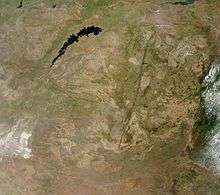Great Dyke

The Great Dyke is a linear geological feature that trends nearly north-south through the centre of Zimbabwe passing just to the west of the capital, Harare. It consists of a band of short, narrow ridges and hills spanning for approximately 550 kilometres (340 mi). The hills become taller as the range goes north, and reach up to 460 metres (1,510 ft) above the Mvurwi Range. The range is host to vast ore deposits, including gold, silver, chromium, platinum, nickel and asbestos.[1]
| Northern end | 16°27′51″S 31°08′24″E / 16.46417°S 31.14000°E |
| Southern end | 20°50′22″S 29°39′04″E / 20.83944°S 29.65111°E |
Geology

Geologically the Great Dyke is not a dyke, but is lopolithic[2] and Y-shaped in cross-section. It is a group of layered ultramafic intrusions that extend across Zimbabwe with a strike of about N20°E. The width of the intrusions vary from 3 to 12 km (7.5 mi). The Great Dyke is unusual in that most ultramafic layered intrusions display near horizontal sill or sheet forms.
The well-layered lower units of ultramafic rocks comprising the Great Dyke are locally overlain by erosional remnants of gabbroic rock. These mark the centres of the four sub-chambers within the Great Dyke magma system, namely (from north to south) Musengezi, Darwendale, Sebakwe and Wedza. Each of these sub-chambers has an elongate, doubly plunging synclinal structure, and was fed by a feeder dyke continuous below almost the entire Great Dyke.[3] Stratigraphically each sub-chamber is divided into a lower Ultramafic Sequence of dunites, harzburgites, olivine bronzitites and pyroxenites together with narrow layers of chromitite that constitute the bases of cyclic units and that are extensively mined along the Great Dyke, and an upper Mafic Sequence mainly consisting of a variety of plagioclase-rich rocks, such as norites, gabbronorites and olivine gabbros.[4]
The dyke lies within the Zimbabwe craton and has been dated at 2.575 billion years old.[5] The Great Dyke acts as a strain-marker for the craton: The fact that it has been undeformed since intrusion (excluding the Musengezi area) shows that the craton had stabilised by the time the Dyke intruded.[6]
Two mafic dykes, the East and Umvimeela, flank the Great Dyke to the east and west respectively. Volcanic surface manifestation of the Great Dyke event has not been recorded and have probably been eroded.[3]
The Great Dyke is a strategic economic resource with significant quantities of chrome and platinum. Chromite occurs to the base of the Ultramafic Sequence and is mined throughout the dyke.[4] Below the Ultramafic-Mafic sequences' contact, and in the uppermost pyroxenite (bronzitite and websterite) units are economic concentrations of nickel, copper, cobalt, gold, and platinum group metals (PGM). The base metals occur as disseminated inter-cumulus Fe-Ni-Cu sulfides within an interval referred to as the base metal subzone, below which is a sublayer enriched in platinum group metals called the PGE subzone. The base metal and PGE subzones together, make up the Main Sulphide Zone (MSZ).[7]
Development

The Great Dyke was first reported in 1867 by the explorer Karl Mauch. However the existence of rich ore deposits was not realized until around 1918.
Chromite is mined throughout the Dyke, especially in the Darwendale, Lalapanzi and Mutorashanga areas. The three largest chrome mining companies are Maranatha Ferrochrome, Zimalloys and Zimasco,[8] although most mines are worked by the tribute system.
Platinum group metals are currently mined at Ngezi Mine south of Selous by Zimplats of the Impala Platinum Group, at Unki Mine near Shurugwi by Anglo American and at Mimosa Mine near Zvishavane by Zimasco for Impala Platinum. The Hartley Platinum Mine near Makwiro is not currently operating.[9][10] Oxidized, near-surface ores are a promising future source for platinum-group metals because of their easy accessibility. They constitute a resource of ca. 160-400 Mt, but mining has so far been hampered due to insufficient recovery rates.[11][12]
See also
References
- ↑ Guilbert, J.M., and Park, C.F.Jr. 1986 The Geology of Ore Deposits, Freeman, ISBN 0-7167-1456-6
- ↑ Hughes, Charles James (1970) Lateral Cryptic Variation in the Great Dyke of Rhodesia, Geological Magazine, Volume 107, Issue 4, pages 319-325. Retrieved 2013-12-01.
- 1 2 Wilson, A.H. and Prendergast, M.D., 1989. The Great Dyke of Zimbabwe-I: tectonic setting, stratigraphy, petrology, structure, emplacement and crystallisation. In: Prendergast, M.D., Jones, M.J. (Eds.), Magmatic sulphides-the Zimbabwe volume. Institution Mining Metallurgy, London, 1–20. ISBN 978-1-870706-06-3
- 1 2 Prendergast, M.D. and Wilson, A.H. 1989. The Great Dyke of Zimbabwe-II: Mineralisation and mineral deposits. In: Prendergast, M.D., Jones, M.J. (Eds.), Magmatic sulphides-the Zimbabwe volume. Institution Mining Metallurgy, London, 21-42. ISBN 978-1-870706-06-3
- ↑ Oberthuer, T., Davis, D.W., Blenkinsop, T.G., Hoehndorf, A., 2002. Precise U–Pb mineral ages, Rb–Sr and Sm–Nd systematics for the Great Dyke, Zimbabwe—constraints on crustal evolution and metallogenesis of the Zimbabwe Craton. Precambrian Research, 113, 293–306.
- ↑ Dirks, P.H.G.M. and Jesma, H.A. 2002. Crust–mantle decoupling and the growth of the Archaean Zimbabwe craton. Journal of African Earth Sciences, 34, 157–166
- ↑ Stribrny, B., Wellmer, F.-W., Burgath, K.-P., Oberthür, T., Tarkian, M. and Pfeiffer, T. 2000. Unconventional PGE occurrences and PGE mineralization in the Great Dyke: metallogenic and economic aspects. Mineralium Deposita, 35, 260-281.
- ↑ Africa: Mining - Chromite Mining Mbendi
- ↑ Platinum occurrences on the Great Dyke Zimplats website
- ↑ Why existing investors are unenthusiastic about Zimbabwe sanctions Zimbabwe Review
- ↑ Locmelis, M., Melcher, F., Oberthür, T. 2010. Platinum-group element distribution in the oxidized Main Sulfide Zone, Great Dyke, Zimbabwe.Mineralium Deposita, 45, 93-109.
- ↑ Oberthür, T., Melcher, F., Buchholz, P., Locmelis, M. 2012. The oxidized ores of the Main Sulfide Zone, Great Dyke, Zimbabwe: Turning resources into minable reserves – mineralogy is the key.In: Platinum 2012, The Southern African Institute of Mining and Metallurgy (SAIMM), Symposium Series, S72, 647-672.